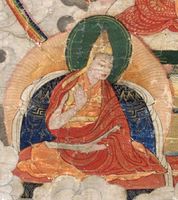Rgyal tshab rje dar ma rin chen
Jump to navigation
Jump to search
Rgyal tshab rje dar ma rin chen on the DRL
རྒྱལ་ཚབ་རྗེ་དར་མ་རིན་ཆེན་
| Wylie | rgyal tshab rje dar ma rin chen |
|---|---|
| English Phonetics | Gyaltsap Je Darma Rinchen |
Other names
- རྒྱལ་ཚབ་རྗེ་
- དགའ་ལྡན་ཁྲི་པ་༠༢་
- rgyal tshab rje
- dga' ldan khri pa 02
Alternate names
- Ganden Tripa, 2nd
Dates
| Birth: | 1364 |
|---|---|
| Death: | 1432 |
| Place of birth: | myang stod ri nang (gtsang) |
Tibetan calendar dates
| Day | |
|---|---|
| Month | |
| Gender | Male |
| Element | Wood |
| Animal | Dragon |
| Rab Jyung | 6 |
About
- Religious Affiliation
- Geluk
- Teachers
- Tsong kha pa · Red mda' ba gzhon nu blo gros
- Students
- 'jam dbyangs chos rje bkra shis dpal ldan · Dalai Lama, 1st · mkhas grub rje · 'dul 'dzin grags pa rgyal mtshan
Other Biographical info:
Alternative birth date 1362.
- one of the two chief disciples of tsong kha pa and his first successor on the seat of dga' ldan, 1419-1431.
- dga' ldan dgon pa dang brag yer pa'i lo rgyus (p. 58)
- birth 1364 at ri nang (nyang stod)
- Assumes Office 1419 Dga' ldan khri at dga' ldan dgon (stag rtse rdzong)
- Leaves Office 1431 Dga' ldan khri at dga' ldan dgon (stag rtse rdzong)
- death 1432
- Took the degree of dka' bcu pa at sa skya, gsang phu, and rtsed thang.
- debated against rong ston and against g.yag phrug pa.
- 1419: came to the throne of dga' ldan and served ll years.
- gsung 'bum in 8 volumes.
Links
- BDRC Link
- https://www.tbrc.org/#!rid=P65
- Treasury of Lives Link
- https://treasuryoflives.org/biographies/view/Gyeltsab-Darma-Rinchen/9095
- Wiki Pages
- Rgyal tshab rje dar ma rin chen on the DRL
- Rgyal tshab rje dar ma rin chen on the LIB
- Rgyal tshab rje dar ma rin chen on the BNW
Buddha Nature Project
- Person description or short bio
Expand to see this person's philosophical positions on Buddha-nature.
| Is Buddha-nature considered definitive or provisional? | |
|---|---|
| Position: | Definitive |
| Notes: | "So, Gyeltsap claims that both the Madhyamakāvatāra and the Uttaratantra explain the same meaning of ultimate truth. Hence, they are both definitive works that explicate the intention of the middle wheel." Wangchuk, Tsering, The Uttaratantra in the Land of Snows, p. 107. |
| All beings have Buddha-nature | |
| Position: | Qualified Yes |
| If "Qualified", explain: | "Gyeltsap thus shows that ultimately both buddhas and sentient beings share the same suchness of mind which is the ultimate nature of mind that is free from natural defilements. Because of this he argues that all sentient beings have tathāgata-essence, and it is through this that he establishes the connection between tathāgata-essence and the concept of one-vehicle, the notion that ultimately there is only the final goal of buddhahood." |
| Notes: | Wangchuk, Tsering, The Uttaratantra in the Land of Snows, p. 99. |
| Which Wheel Turning | |
| Position: | Second Turning |
| Notes: | "So, Gyeltsap claims that both the Madhyamakāvatāra and the Uttaratantra explain the same meaning of ultimate truth. Hence, they are both definitive works that explicate the intention of the middle wheel." Wangchuk, Tsering, The Uttaratantra in the Land of Snows, p. 107.
|
| Yogācāra vs Madhyamaka | |
| Position: | Madhyamaka |
| Notes: | *"In his Uttaratantra commentary, Gyeltsap shows the strong influence of Tsongkhapa's Illuminating the Thoughts of the Madhyamaka. He criticizes those who propose that the Uttaratantra is a Cittamātra text, arguing that it explicates the ultimate truth presented in the Prāsaṅgika-Madhyamaka." Wangchuk, Tsering, The Uttaratantra in the Land of Snows, p. 98.
|
| Zhentong vs Rangtong | |
| Position: | Rangtong |
| Notes: | |
| Promotes how many vehicles? | |
| Position: | 1 |
| Notes: | "Gyeltsap thus shows that ultimately both buddhas and sentient beings share the same suchness of mind which is the ultimate nature of mind that is free from natural defilements. Because of this he argues that all sentient beings have tathāgata-essence, and it is through this that he establishes the connection between tathāgata-essence and the concept of one-vehicle, the notion that ultimately there is only the final goal of buddhahood." Wangchuk, Tsering, The Uttaratantra in the Land of Snows, p. 99. |
| Analytic vs Meditative Tradition | |
| Position: | |
| Notes: | |
| What is Buddha-nature? | |
| Position: | Tathāgatagarbha as the Emptiness That is a Non-implicative Negation (without enlightened qualities) |
| Notes: | "In brief, Gyeltsap argues that buddha-nature, or tathāgata-essence, does not refer to a fully enlightened entity covered by adventitious defilements. Rather it is the same as the emptiness of inherent existence that is explicated in texts such as the Prajñāpāramitāsūtras and Madhyamakāvatāra." Wangchuk, Tsering, The Uttaratantra in the Land of Snows, p. 106. |
| Svātantrika (རང་རྒྱུད་) vs Prāsaṅgika (ཐལ་འགྱུར་པ་) | |
| Position: | Prāsaṅgika (ཐལ་འགྱུར་) |
| Notes: | *"In his Uttaratantra commentary, Gyeltsap shows the strong influence of Tsongkhapa's Illuminating the Thoughts of the Madhyamaka. He criticizes those who propose that the Uttaratantra is a Cittamātra text, arguing that it explicates the ultimate truth presented in the Prāsaṅgika-Madhyamaka." Wangchuk, Tsering, The Uttaratantra in the Land of Snows, p. 98.
|
| Causal nature of the vajrapāda | |
| Position: | |
